Opel Meriva (2017 year). Instruction — part 13
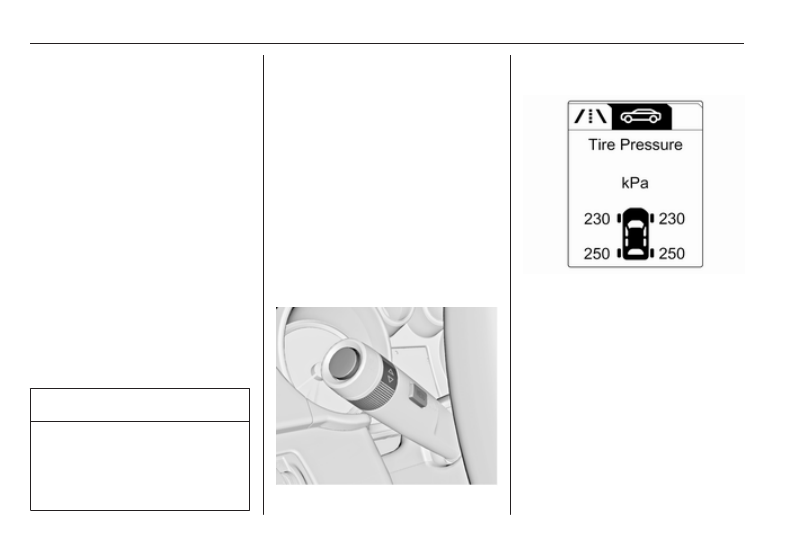
198
Vehicle care
values provided on the tyre
information label and tyre pressure
chart are valid for cold tyres, which
means at 20 °C.
The pressure increases by nearly
10 kPa for a 10 °C temperature
increase. This must be considered
when warm tyres are checked.
The tyre pressure value displayed in
the Driver Information Centre shows
the real tyre pressure. A cooled down
tyre will show a decreased value,
which does not indicate an air leak.
Tyre pressure monitoring
system
The tyre pressure monitoring system
checks the pressure of all four wheels
once a minute when vehicle speed
exceeds a certain limit.
Caution
Tyre pressure monitoring system
warns only about low tyre pressure
condition and does not replace
regular tyre maintenance by the
driver.
All wheels must be equipped with
pressure sensors and the tyres must
have the prescribed pressure.
Note
In countries where the tyre pressure
monitoring system is legally
required, the use of wheels without
pressure sensors will invalidate the
vehicle type approval.
The current tyre pressures can be
shown in the Vehicle Information
Menu in the Driver Information
Centre.
The menu can be selected by the
buttons on the turn signal lever.
Press MENU to select the Vehicle
Information Menu X.
Turn the adjuster wheel to select the
tyre pressure monitoring system.
System status and pressure warnings
are displayed by a message
indicating the corresponding tyre in
the Driver Information Centre.
The system considers the tyre
temperature for the warnings.
Temperature dependency 3 197.
-------------------------------------------------------------------------------------------------------------------------------------------------------------

Vehicle care
199
A detected low tyre pressure
condition is indicated by the control
indicator w 3 98.
If w illuminates, stop as soon as
possible and inflate the tyres as
recommended 3 235.
If w flashes for 60-90 seconds and
then illuminates continuously, there is
a fault in the system. Consult a
workshop.
After inflating, driving may be
required to update the tyre pressure
values in the Driver Information
Centre. During this time w may
illuminate.
If w illuminates at lower temperatures
and extinguishes after some driving,
this could be an indicator for
approaching a low tyre pressure
condition. Check tyre pressure.
Vehicle messages 3 106.
If the tyre pressure shall be reduced
or increased, switch off ignition.
Only mount wheels with pressure
sensors, otherwise the tyre pressure
will not be displayed and w
illuminates continuously.
A temporary spare wheel is not
equipped with pressure sensors. The
tyre pressure monitoring system is
not operational for these wheels.
Control indicator w illuminates. For
the further three wheels the system
remains operational.
The use of commercially available
liquid tyre repair kits can impair the
function of the system. Factory-
approved repair kits can be used.
Operating electronic devices or being
close to facilities using similar wave
frequencies could disrupt the tyre
pressure monitoring system.
Each time the tyres are replaced tyre
pressure monitoring system sensors
must be dismounted and serviced.
For the screwed sensor: replace
valve core and sealing ring. For
clipped sensor: replace complete
valve stem.
Vehicle loading status
Adjust tyre pressure to load condition
according to tyre information label or
tyre pressure chart 3 235, and select
the relevant setting in the menu Tyre
Load in the Driver Information Centre,
Vehicle Information Menu 3 101. This
setting is the reference for the tyre
pressure warnings.
The Tyre Load menu only appears if
the vehicle is in a standstill and the
parking brake is applied. On vehicles
with automatic transmission the
selector lever has to be in P.
-------------------------------------------------------------------------------------------------------------------------------------------------------------
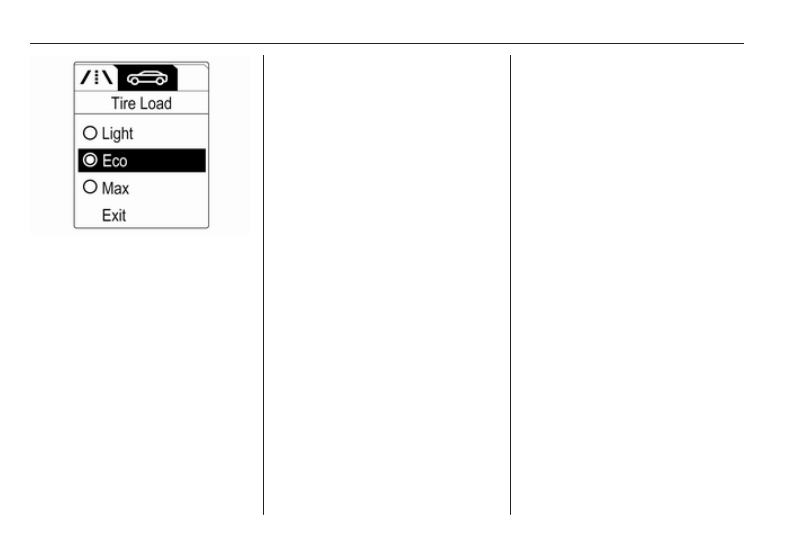
200
Vehicle care
Select:
● Light for comfort pressure up to
3 people.
● Eco for Eco pressure up to
3 people.
● Max for full loading.
Tyre pressure sensor matching
process
Each tyre pressure sensor has a
unique identification code. The
identification code must be matched
to a new wheel position after rotating
the wheels or exchanging the
complete wheel set and if one or more
tyre pressure sensors were replaced.
The tyre pressure sensor matching
process should also be performed
after replacing a spare wheel with a
road wheel containing the tyre
pressure sensor.
The malfunction light w and the
warning message or code should go
off at the next ignition cycle. The
sensors are matched to the wheel
positions, using a relearn tool, in the
following order: left side front wheel,
right side front wheel, right side rear
wheel and left side rear wheel. The
turn signal light at the current active
position is illuminated until sensor is
matched.
Consult a workshop for service or
purchase a relearn tool. There are
two minutes to match the first wheel
position, and five minutes overall to
match all four wheel positions. If it
takes longer, the matching process
stops and must be restarted.
The tyre pressure sensor matching
process is:
1. Apply the parking brake.
2. Turn the ignition on.
3. On vehicles with automatic
transmission: set the selector
lever to P.
On vehicles with instruction
transmission: select neutral.
4. Press MENU on the turn signal
lever to select the Vehicle
Information Menu in the Driver
Information Centre.
5. Turn the adjuster wheel to scroll to
the tyre pressure menu.
6. Press SET/CLR to begin the
sensor matching process. A
message requesting acceptance
of the process should display.
7. Press SET/CLR again to confirm
the selection. The horn sounds
twice to signal the receiver is in
relearn mode.
8. Start with the left side front wheel.
9. Place the relearn tool against the
tyre sidewall, near the valve stem.
Then press the button to activate
the tyre pressure sensor. A horn
chirp and the brief activation of all
turn signal lights confirm that the
-------------------------------------------------------------------------------------------------------------------------------------------------------------

Vehicle care
201
sensor identification code has
been matched to this wheel
position.
10. Proceed to the right side front
wheel, and repeat the procedure
in Step 9.
11. Proceed to the right side rear
wheel, and repeat the procedure
in Step 9.
12. Proceed to the left side rear
wheel, and repeat the procedure
in Step 9. The horn sounds twice
to ind
icate the sensor identification
code has been matched to the left
side rear wheel, and the tyre
pressure sensor matching
process is no longer active.
13. Turn off the ignition.
14. Set all four tyres to the
recommended air pressure level
as indicated on the tyre pressure
information label.
15. Ensure the tyre loading status is
set according selected pressure
Tread depth
Check tread depth at regular
intervals.
Tyres should be replaced for safety
reasons at a tread depth of 2-3 mm
(4 mm for winter tyres).
For safety reasons it is recommended
that the tread depth of the tyres on
one axle should not vary by more than
2 mm.
The legally permissible minimum
tread depth (1.6 mm) has been
reached when the tread has worn
down as far as one of the tread wear
indicators (TWI). Their position is
indicated by markings on the
sidewall.
If there is more wear at the front than
the rear, swap round front wheels and
rear wheels periodically. Ensure that
the direction of rotation of the wheels
remains the same.
Tyres age, even if they are not used.
We recommend tyre replacement
every 6 years.
Changing tyre and wheel
size
If tyres of a different size than those
fitted at the factory are used, it may be
necessary to reprogramme the
speedometer as well as the nominal
tyre pressure and make other vehicle
modifications.
After converting to a different tyre
size, have the label with tyre
pressures replaced.
-------------------------------------------------------------------------------------------------------------------------------------------------------------

202
Vehicle care
9 Warning
Use of unsuitable tyres or wheels
may lead to accidents and will
invalidate the vehicle type
approval.
Wheel covers
Wheel covers and tyres that are
factory approved for the respective
vehicle and comply with all of the
relevant wheel and tyre combination
requirements must be used.
If the wheel covers and tyres used are
not factory approved, the tyres must
not have a rim protection ridge.
Wheel covers must not impair brake
cooling.
9 Warning
Use of unsuitable tyres or wheel
covers could lead to sudden
pressure loss and thereby
accidents.
Steel wheels: When using locking
wheel bolts, do not attach wheel
covers.
Tyre chains
Tyre chains are only permitted on the
front wheels.
Always use fine mesh chains that add
no more than 10 mm to the tyre tread
and the inboard sides (including chain
lock).
9 Warning
Damage may lead to tyre blowout.
Tyre chains are only permitted on
tyres of size 195/65 R15,
205/55 R16 and 225/45 R17.
Tyre chains are not permitted on tyres
of size 225/40 R18.
The use of tyre chains is not permitted
on the temporary spare wheel.
Tyre repair kit
Minor damage to the tyre tread can be
repaired with the tyre repair kit.
Do not remove foreign bodies from
the tyres.
Tyre damage exceeding 4 mm or that
is at the tyre's sidewall near the rim
cannot be repaired with the tyre repair
kit.
9 Warning
Do not drive faster than 80 km/h.
Do not use for a lengthy period.
Steering and handling may be
affected.
If you have a flat tyre:
-------------------------------------------------------------------------------------------------------------------------------------------------------------

Vehicle care
203
Apply the parking brake and engage
first gear, reverse gear or P.
The tyre repair kit is stowed in the load
compartment.
Depending on the equipment, the tyre
repair kit is in a compartment in the
right sidewall or in a compartment
under the floor cover.
Vehicles with tyre repair kit in the
sidewall
To open the compartment, disengage
the cover and open it.
1. Take the sealant bottle and
bracket with air hose from the
insert.
2. Detach air hose from bracket and
screw onto sealant bottle
connection.
3. Position the sealant bottle on the
bracket. Make sure that the bottle
does not fall.
-------------------------------------------------------------------------------------------------------------------------------------------------------------
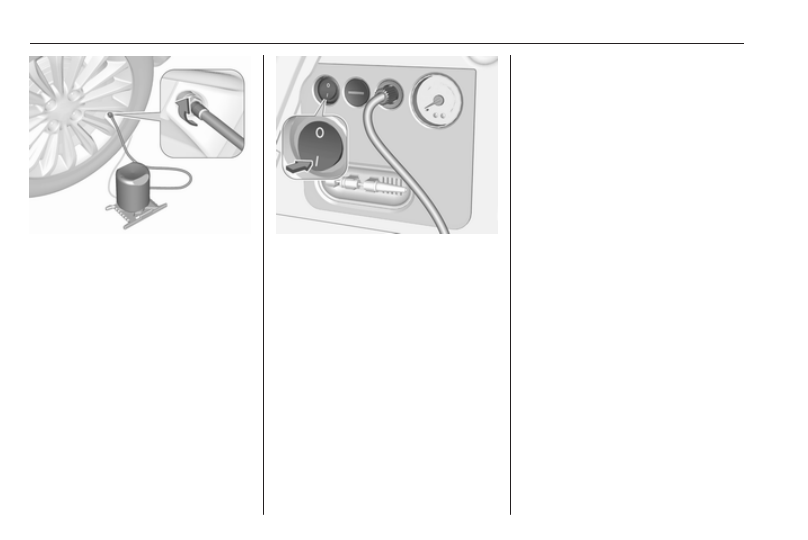
204
Vehicle care
4. Unscrew valve cap from defective
tyre.
5. Screw tyre inflation hose to valve.
6. Screw air hose onto compressor
connection.
7. Switch on ignition.
To avoid discharging the vehicle
battery, we recommend running
the engine.
8. Press on/off switch on the
compressor. The tyre is filled with
sealant.
9. The compressor pressure gauge
briefly indicates up to 6 bar whilst
the sealant bottle is emptying
(approx. 30 seconds). Then the
pressure starts to drop.
10. All of the sealant is pumped into
the tyre. Then the tyre is inflated.
11. The prescribed tyre pressure
should be obtained within
10 minutes. Tyre pressure
235. When the correct pressure
is obtained, switch off the
compressor by pressing the on/off
switch again.
If the prescribed tyre pressure is
not obtained within 10 minutes,
remove the tyre repair kit. Move
the vehicle one tyre rotation.
Reattach the tyre repair kit and
continue the filling procedure for
10 minutes. If the prescribed tyre
pressure is still not obtained, the
tyre is too badly damaged. Seek
the assistance of a workshop.
Release excess tyre pressure by
pressing ].
Do not run the compressor longer
than 10 minutes.
12. Push catch on bracket to remove
sealant bottle from bracket. Screw
the tyre inflation hose to the free
connection of the sealant bottle.
This prevents sealant from
escaping. Stow tyre repair kit in
load compartment.
13. Remove any excess sealant
using a cloth.
14. Take the label indicating
maximum permitted speed from
the sealant bottle and affix in the
driver's field of view.
-------------------------------------------------------------------------------------------------------------------------------------------------------------

Vehicle care
205
15. Continue driving immediately so
that sealant is evenly distributed
in the tyre. After driving approx.
10 km (but no more than
10 minutes), stop and check tyre
pressure. Screw compressor air
hose directly onto tyre valve and
compressor when doing this.
If tyre pressure is more than
1.3 bar, set it to the correct value.
Repeat the procedure until there
is no more loss of pressure.
If the tyre pressure has fallen
below 1.3 bar, the vehicle must
not be used. Seek the assistance
of a workshop.
16. Stow away tyre repair kit in load
compartment.
Vehicles with tyre repair kit under
the floor cover
1. Take the tyre repair kit from the
compartment.
2. Remove the compressor.
3. Remove the electrical connection
cable and air hose from the
stowage compartments on the
underside of the compressor.
-------------------------------------------------------------------------------------------------------------------------------------------------------------

206
Vehicle care
4. Screw the compressor air hose to
the connection on the sealant
bottle.
5. Fit the sealant bottle into the
retainer on the compressor.
Set the compressor near the tyre
in such a way that the sealant
bottle is upright.
6. Unscrew valve cap from defective
tyre.
7. Screw the filler hose to the tyre
valve.
8. The switch on the compressor
must be set to J.
9. Connect the compressor plug to
the power outlet or cigarette
lighter socket.
To avoid discharging the battery,
we recommend running the
engine.
10. Set the rocker switch on the
compressor to I. The tyre is filled
with sealant.
11. The compressor pressure gauge
briefly indicates up to 6 bar whilst
the sealant bottle is emptying
(approx. 30 seconds). Then the
pressure starts to drop.
12. All of the sealant is pumped into
the tyre. Then the tyre is inflated.
13. The prescribed tyre pressure
should be obtained within
10 minutes. Tyre pressure
235. When the correct pressure
is obtained, switch off the
compressor.
If the prescribed tyre pressure is
not obtained within 10 minutes,
remove the tyre repair kit. Move
the vehicle one tyre rotation.
Reattach the tyre repair kit and
continue the filling procedure for
10 minutes. If the prescribed tyre
pressure is still not obtained, the
tyre is too badly damaged. Seek
the assistance of a workshop.
-------------------------------------------------------------------------------------------------------------------------------------------------------------
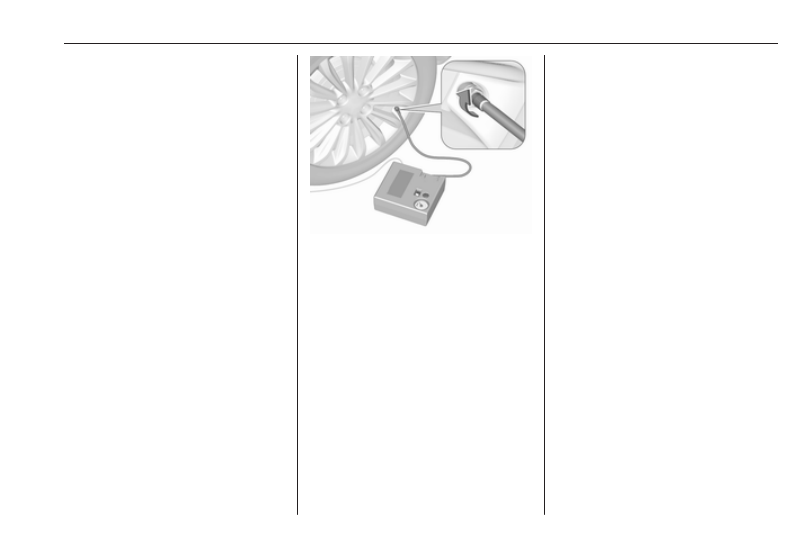
Vehicle care
207
Drain excess tyre pressure with
the button over the pressure
indicator.
Do not run the compressor longer
than 10 minutes.
14. Detach the tyre repair kit. Push
catch on bracket to remove
sealant bottle from bracket. Screw
the tyre inflation hose to the free
connection of the sealant bottle.
This prevents sealant from
escaping. Stow tyre repair kit in
load compartment.
15. Remove any excess sealant
using a cloth.
16. Take the label indicating
maximum permitted speed from
the sealant bottle and affix in the
driver's field of view.
17. Continue driving immediately so
that sealant is evenly distributed
in the tyre. After driving approx.
10 km (but no more than
10 minutes), stop and check tyre
pressure. Screw compressor air
hose directly onto tyre valve and
compressor when doing this.
If tyre pressure is more than
1.3 bar, set it to the correct value.
Repeat the procedure until there
is no more loss of pressure.
If the tyre pressure has fallen
below 1.3 bar, the vehicle must
not be used. Seek the assistance
of a workshop.
18. Stow away tyre repair kit in load
compartment.
General information
Note
The driving characteristics of the
repaired tyre are severely affected,
therefore have this tyre replaced.
If unusual noise is heard or the
compressor becomes hot, turn
compressor off for at least
30 minutes.
The built-in safety valve opens at a
pressure of 7 bar.
Note the expiry date of the kit. After
this date its sealing capability is no
longer guaranteed. Pay attention to
storage information on sealant
bottle.
Replace the used sealant bottle.
Dispose of the bottle as prescribed
by applicable laws.
The compressor and sealant can be
used from approx. -30 °C.
The adapters supplied can be used
to pump up other items e.g.
footballs, air mattresses, inflatable
dinghies etc. They are located on the
underside of the compressor. To
remove, screw on compressor air
hose and withdraw adapter.
Wheel changing
Some vehicles are equipped with a
tyre repair kit instead of a spare wheel
-------------------------------------------------------------------------------------------------------------------------------------------------------------
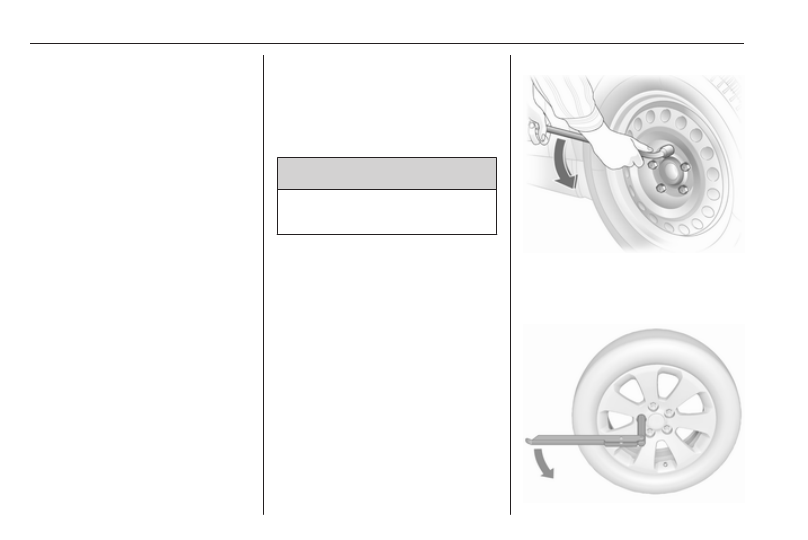
208
Vehicle care
Make the following preparations and
observe the following information:
● Park the vehicle on a level, firm
and non-skid surface. The front
wheels must be in the straight-
ahead position.
● Apply the parking brake and
engage first gear, reverse gear or
P.
● Remove the spare wheel 3 210.
● Never change more than one
wheel at once.
● Use the jack only to change
wheels in case of puncture, not
for seasonal winter or summer
tyre change.
● The jack is maintenance-free.
● If the ground on which the vehicle
is standing is soft, a solid board
(max. 1 cm thick) should be
placed under the jack.
● Take heavy objects out of the
vehicle before jacking up.
● No people or animals may be in
the vehicle when it is jacked-up.
● Never crawl under a jacked-up
vehicle.
● Do not start the vehicle when it is
raised on the jack.
● Before screwing in the wheel
bolts, clean them and lightly coat
the taper of each wheel bolt with
commercially available grease.
9 Warning
Do not grease the thread of the
wheel bolt.
1. Pull off the wheel cover.
For wheel covers with visible
wheel bolts: The cover can remain
on the wheel. Do not remove the
retaining rings on the wheel bolts.
Alloy wheels: Disengage wheel
bolt caps with a screwdriver and
remove. To protect the wheel,
place a soft cloth between the
screwdriver and the alloy wheel.
2. Variant 1:
Install the wheel wrench ensuring
that it locates securely and loosen
each wheel bolt by half a turn.
Variant 2:
-------------------------------------------------------------------------------------------------------------------------------------------------------------
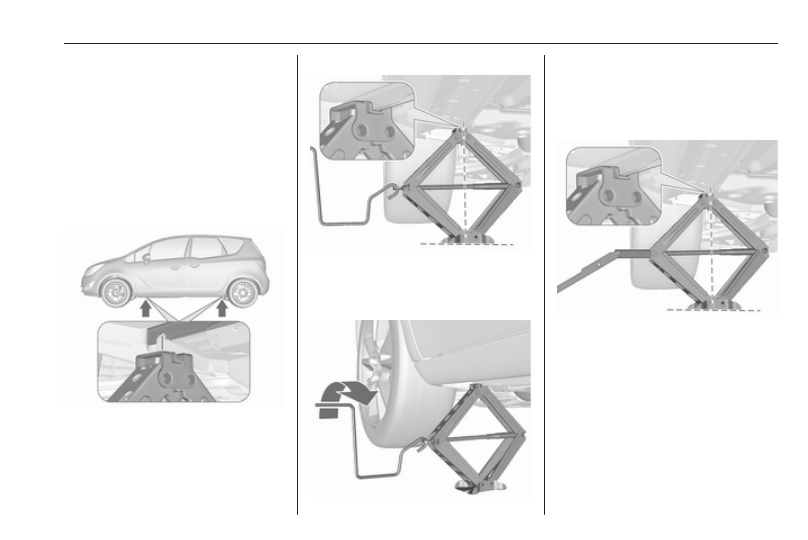
Vehicle care
209
Fold out the wheel wrench and
install ensuring that it locates
securely and loosen each wheel
bolt by half a turn.
The wheels might be protected by
locking wheel bolts. To loosen
these specific bolts first attach the
adapter onto the head of the bolt
before installing the wheel
wrench. The adapter is located in
the glovebox.
3. Ensure the jack is positioned
correctly with the vehicle jacking
points.
4. Variant 1:
Set the jack to the necessary
height. Position it directly below
the jacking point in a manner that
prevents it from slipping.
Attach jack handle and with the
jack correctly aligned rotate
handle until wheel is clear of the
ground.
Variant 2:
Set the jack to the necessary
height. Position it directly below
the jacking point in a manner that
prevents it from slipping.
-------------------------------------------------------------------------------------------------------------------------------------------------------------
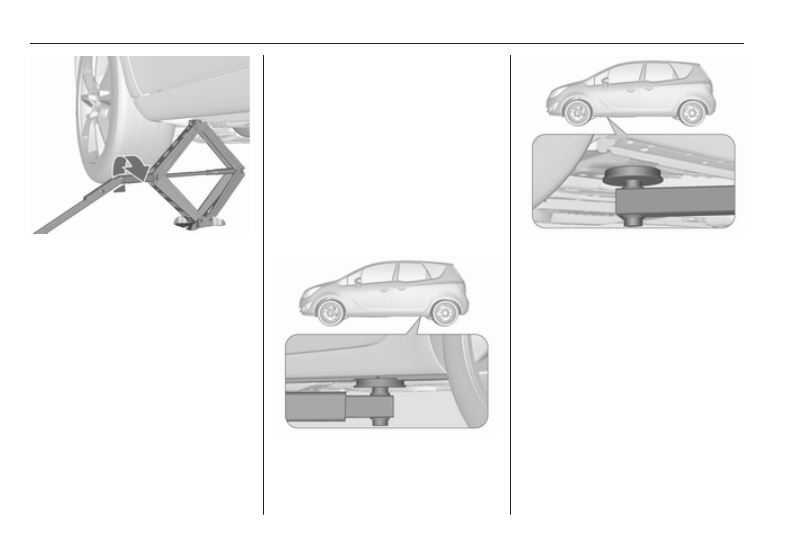
210
Vehicle care
Attach wheel wrench and with the
jack correctly aligned rotate wheel
wrench until wheel is clear of the
ground.
5. Unscrew the wheel bolts.
6. Change the wheel.
7. Screw on the wheel bolts.
8. Lower vehicle.
9. Install the wheel wrench ensuring
that it locates securely and tighten
each bolt in a crosswise
sequence. Tightening torque is
110 Nm.
10. Align the valve hole in the wheel
cover with the tyre valve before
installing.
Install wheel bolt caps.
11. Stow the replaced wheel 3 210,
the vehicle tools 3 195 and the
adapter for the locking wheel bolts
12. Check the tyre pressure of the
installed tyre and also the wheel
bolt torque as soon as possible.
Have the defective tyre renewed or
repaired.
Jacking position for lifting platform
Rear arm position of the lifting
platform at the underbody.
Front arm position of the lifting
platform at the underbody.
Spare wheel
Some vehicles are equipped with a
tyre repair kit instead of a spare
wheel.
If mounting a spare wheel, which is
different from the other wheels, this
wheel might be classified as a
temporary spare wheel and the
corresponding speed limits apply,
even though no label indicates this.
Seek the assistance of a workshop to
check the applicable speed limit.
The spare wheel has a steel rim.
-------------------------------------------------------------------------------------------------------------------------------------------------------------
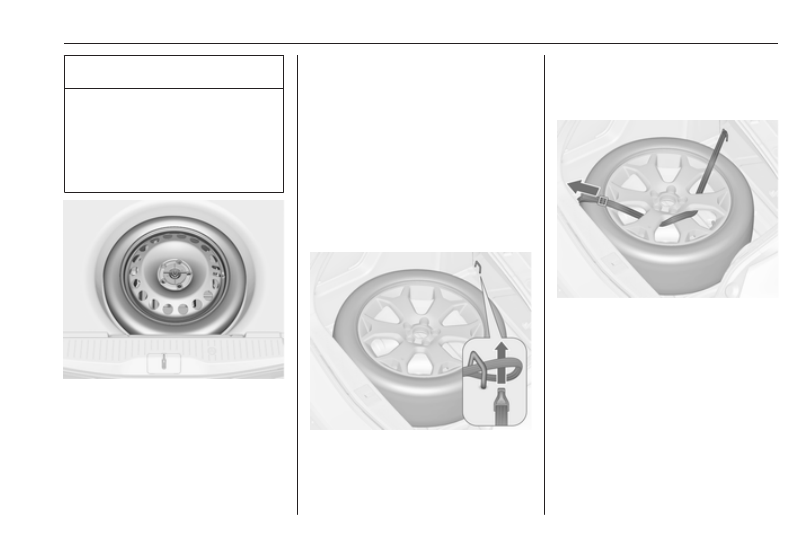
Vehicle care
211
Caution
The use of a spare wheel that is
smaller than the other wheels or in
combination with winter tyres
could affect driveability. Have the
defective tyre replaced as soon as
possible.
The spare wheel is located in the load
compartment beneath the floor
covering. It is secured with a wing nut.
The spare wheel well is not designed
for all permissible tyre sizes. If a
wheel wider than the spare wheel has
to be stowed in the load
compartment, it must be secured with
a strap or, depending on the version,
with an extension bar.
Storing a replaced wheel in the
load compartment using a strap
Use the strap placed in the tool box.
Vehicle tools 3 195.
● Position the wheel on the load
compartment floor close to one
sidewall of the load
compartment.
● Place the loop end of the strap
through the front lashing eye of
the according side.
● Place the hook end of the strap
through the loop and pull it until
the strap is fastened securely to
the lashing eye.
● Insert the strap through the
spokes of the wheel as shown in
the illustration.
● Mount the hook to the rear
lashing eye.
● Tighten the strap and secure it
using the buckle.
-------------------------------------------------------------------------------------------------------------------------------------------------------------

212
Vehicle care
Storing a replaced wheel in the
spare wheel well using an
extension bar
Use the extension bar placed in the
tool box. Vehicle tools 3 195.
● Turn the wing nut anticlockwise
and remove temporary spare
wheel.
● Take the extension bar from the
tool box and screw it on the bolt.
● Store the damaged wheel and
secure it by turning the wing nut
clockwise.
The floor cover can be placed on the
projecting wheel.
Remove the extension bar before
fitting the spare wheel in the well after
renewing or repairing the defective
wheel.
9 Warning
Storing a jack, a wheel or other
equipment in the load
compartment could cause injury if
they are not fixed properly. During
a sudden stop or a collision, loose
equipment could strike someone.
Store jack and tools always in the
respective storage compartments
and secure them by fixing.
Place the damaged wheel always
in the load compartment secured
by the strap or in the spare wheel
well secured by the wing nut.
Temporary spare wheel
Caution
The use of the temporary spare
wheel could affect driveability.
Have the defective tyre renewed
or repaired as soon as possible.
Only mount one temporary spare
wheel. The permissible maximum
speed on the label on the temporary
spare wheel is only valid for the
factory-fitted tyre size.
If your vehicle gets a flat tyre in the
rear while towing another vehicle,
mount the temporary spare wheel in
the front and the full tyre in the rear.
Tyre chains 3 202.
Spare wheel with directional tyre
If possible, fit directional tyres such
that they roll in the direction of travel.
The rolling direction is indicated by a
symbol (e.g. an arrow) on the
sidewall.
The following applies to tyres fitted
opposing the rolling direction:
● Driveability may be affected.
Have the defective tyre renewed
or repaired as soon as possible
and fit it instead of the spare
wheel.
● Drive particularly carefully on wet
and snow-covered road
surfaces.
-------------------------------------------------------------------------------------------------------------------------------------------------------------
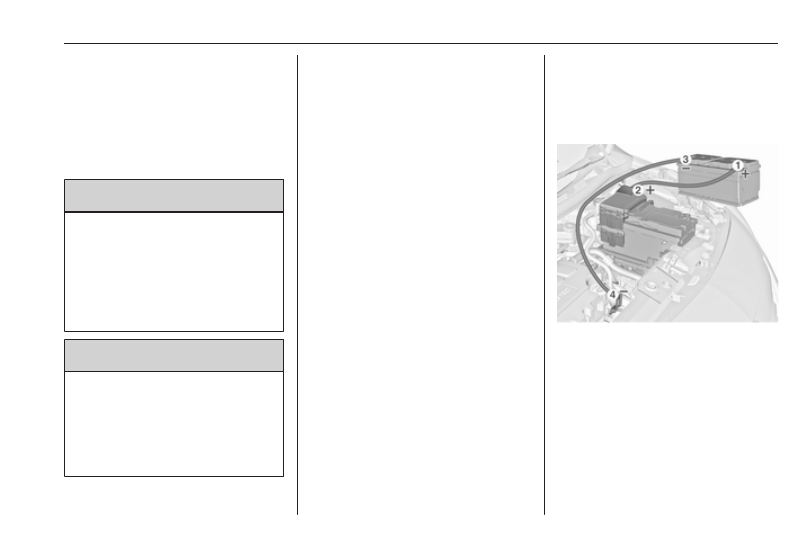
Vehicle care
213
Jump starting
Do not start with quick charger.
A vehicle with a discharged vehicle
battery can be started using jump
leads and the vehicle battery of
another vehicle.
9 Warning
Be extremely careful when starting
with jump leads. Any deviation
from the following instructions can
lead to injuries or damage caused
by vehicle battery explosion or
damage to the electrical systems
of both vehicles.
9 Warning
Avoid contact of the vehicle
battery with eyes, skin, fabrics and
painted surfaces. The fluid
contains sulphuric acid which can
cause injuries and damage in the
event of direct contact.
● Never expose the vehicle battery
to naked flames or sparks.
● A discharged vehicle battery can
already freeze at a temperature
of 0 °C. Defrost the frozen battery
before connecting jump leads.
● Wear eye protection and
protective clothing when
handling a vehicle battery.
● Use a booster battery with the
same voltage (12 volts). Its
capacity (Ah) must not be much
less than that of the discharged
battery.
● Use jump leads with insulated
terminals and a cross section of
at least 16 mm
2
(25 mm
2
for
diesel engines).
● Do not disconnect the discharged
battery from the vehicle.
● Switch off all unnecessary
electrical consumers.
● Do not lean over the battery
during jump starting.
● Do not allow the terminals of one
lead to touch those of the other
lead.
● The vehicles must not come into
contact with each other during
the jump starting process.
● Apply the parking brake,
transmission in neutral,
automatic transmission in P.
● Open the positive terminal
protection caps of both batteries.
Lead connection order:
1. Connect the red lead to the
positive terminal of the booster
battery.
2. Connect the other end of the red
lead to the positive terminal of the
discharged battery.
-------------------------------------------------------------------------------------------------------------------------------------------------------------

Нет комментариевНе стесняйтесь поделиться с нами вашим ценным мнением.
Текст